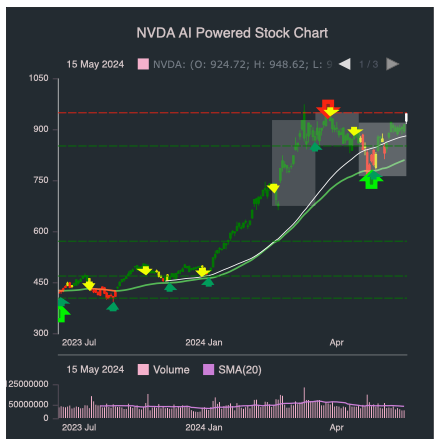20 Pro Facts For Selecting AI Stock Trading Platform Sites
20 Pro Facts For Selecting AI Stock Trading Platform Sites
Blog Article
Top 10 Tips On How To Determine The Quality Of The Data And Its Sources For Ai-Based Stock Analysis/Predicting Trading Platforms
Analyzing the quality of data and sources that are used by AI-driven stock prediction and trading platforms is critical to ensure accurate and reliable insights. A poor quality of data could lead to flawed predictions, to financial losses, or even a lack of trust towards the platform. Here are ten of the most effective strategies to evaluate data sources and quality.
1. Verify the data sources
Verify the source: Ensure that the platform is using information from reliable sources (e.g. Bloomberg, Reuters Morningstar or exchanges like NYSE and NASDAQ).
Transparency. A platform that is transparent will reveal all the sources of its data and keep them updated.
Avoid single-source dependencies: Reliable platforms often aggregate data from several sources to reduce mistakes and bias.
2. Assess Data Freshness
Real-time as opposed to. Delayed Data: Check whether the platform provides real-time information or delayed information. The availability of real-time data is vital for active trading. The delayed data is sufficient for long term analysis.
Update frequency: Determine how often the information is changed (e.g. minute-by-minute daily, hourly).
Historical data accuracy: Ensure the accuracy of your historical data. free from gaps or anomalies.
3. Evaluate Data Completeness
Look for missing data.
Coverage: Ensure the platform offers a broad variety of markets, stocks as well as indices and equity markets that are pertinent to the strategies you use for trading.
Corporate actions: Check that the platform contains stock splits (dividends) and mergers as well as any other corporate actions.
4. Accuracy of Test Data
Cross-verify the data: Compare data from the platform to other data sources that you trust to assure the accuracy of the data.
Error detection: Search for a mismatch in pricing, incorrect financial metrics, or unusual outliers.
Backtesting - Use historical data to back-test trading strategies to see if results match expectations.
5. Assess the Data Granularity
In terms of level of detail, make sure the platform is able to provide a full set of data, including price volumes bidding-asking spreads as well as order book depth.
Financial metrics: Ensure that the platform has complete financial statements (including income statement, balance sheets, and cash flow, along with important ratios (such as P/E, ROE, and P/B. ).
6. Check for Data Cleaning and Processing
Normalization of data. Make sure that the platform is normalizing data in order to keep it consistent (e.g. by adjusting splits, dividends).
Outlier handling: Check the way your system handles anomalies or data that is outliers.
Imputation of missing data is not working - Make sure whether the platform is using solid methods to fill in missing data points.
7. Examine Data Consistency
Aligning data with the time zone: To avoid any discrepancies make sure that all data is in sync with each other.
Format consistency: Determine if the data is formatted in the same format (e.g. units, currency).
Cross-market compatibility: Ensure that the information coming from different markets and exchanges are harmonized.
8. Determine the relevancy of data
Relevance of data to trading strategy: Ensure that your data is in sync to your trading style.
Features selection: Check that the platform has appropriate features that can improve predictions (e.g. sentiment analysis macroeconomic indicator news data).
9. Review Data Security and Integrity
Data encryption: Make sure that the platform is using encryption to secure data as it is transferred and stored.
Tamper-proofing: Make sure that the data is not altered or altered by the platform.
Compliance: Verify that the platform is in compliance with any data protection laws (e.g. GDPR or CPA, etc.).
10. Transparency of the AI Model of the Platform is evaluated
Explainability: Ensure that the platform provides insights into how the AI model makes use of the data to generate predictions.
Bias detection - Check to see if your platform actively monitors models and data for biases.
Performance metrics. Evaluate the performance metrics like precision, accuracy, and recall to assess the reliability of the platform.
Bonus Tips
User reviews and reputation User feedback and reviews to gauge the credibility of the platform as well as its data quality.
Trial time. You can use a free demo or trial to try out the features of the platform.
Customer Support: Ensure that the platform has an efficient support system for customers to help resolve issues with data.
Utilize these suggestions to determine the source of data and the quality of AI software for stock prediction. Make informed decisions about trading using this data. See the top rated website about ai stock market for more advice including ai for investment, ai for stock predictions, ai chart analysis, ai stock market, ai trading tools, chatgpt copyright, ai investment platform, investment ai, ai investing app, ai stock market and more.
Top 10 Ways To Evaluate The Risk Management Of Stock Trading Platforms That Use Ai
Risk management is a crucial element of any AI trading platform for predicting or analyzing stocks, as it helps protect your capital and reduce the risk of losses. A platform that has robust risk management tools will aid you in managing uncertain markets, and make informed decisions. Here are the 10 best strategies for evaluating these platforms' risk management capabilities:
1. Study Stop-Loss Features and Take Profit Features
Level that you can customize: You should be able customize the levels of take-profit and stop-loss for individual trades and strategies.
Examine the platform to determine whether it has a trailing stop feature that will automatically adjust when the market moves your way.
If the platform provides stop-loss orders that guarantee your trade is closed at the specified price in markets that are volatile You can be assured of a profitable trade.
2. Tools to Measure Positions
Fixed amount - Ensure that you know the amount of your positions according to a specific amount.
Percentage of portfolio: Check if you can set size limits in percentages of your total portfolio to reduce risk proportionally.
Risk-reward: Find out if your platform allows you to determine risk-rewards for each trade or strategy.
3. Check for Diversification Assistance
Multi-asset trading : Make sure the platform you choose to use allows you to trade across different asset classes, such as stocks, ETFs and options. This can help you diversify your portfolio.
Sector allocation: Ensure that the platform has tools for monitoring the sector's exposure.
Geographic diversification. Verify whether the platform is able to trade internationally and spread geographic risk.
4. Examine the Margin and Leverage Controls
Margin requirements: Ensure the platform clearly states the requirements for margin for leveraged trading.
Find out if your platform lets you to limit leverage to manage risk exposure.
Margin calls - Examine to see if your service informs you about margin calls in a timely manner. This can help avoid liquidation.
5. Assessment and reporting of risk
Risk metrics: Ensure the platform has key risk metrics (e.g. Value at Risk (VaR), Sharpe ratio, drawdown) to your portfolio.
Scenario assessment: See if you can simulate different market scenarios using the platform in order to determine the potential risk.
Performance reports: Ensure that the platform provides you with detailed information on the performance of your investments, including returns that are risk adjusted.
6. Check for Real-Time Risk Monitoring
Portfolio monitoring: Ensure the platform provides real-time tracking of the risk exposure to your portfolio.
Alerts and notifications: Examine the platform's ability to provide real-time alerts for risksy events (e.g. breached margins or Stop loss triggers).
Check for customizable dashboards that will give you a snapshot of your risk profile.
7. Test Stress Testing and backtesting
Stress testing: Make sure that the platform you select allows the testing of your strategies and portfolio under the most extreme conditions of the market.
Backtesting. Verify that the platform permits backtesting, which involves the application of historical data to evaluate the level of risk and performance.
Monte Carlo simulations: Verify if the platform uses Monte Carlo simulations to model the possibility of outcomes and assess the risk.
8. Risk Management Regulations - Assess Compliance
Regulatory Compliance: Verify the platform's compliance with applicable Risk Management Regulations (e.g. MiFID II for Europe, Reg T for the U.S.).
Best execution: Check if the platform follows the highest standards of execution, and ensures that transactions are executed at the highest available price to minimize slippage.
Transparency: Check to see whether the platform has disclosed risks in a clear, open and transparent manner.
9. Examine for Risks that are User Controlled Parameters
Custom Risk Rules: Ensure that you have the ability to create custom rules for risk management (e.g. an amount that is the maximum daily loss, or a maximum amount of tradeable position).
Automated Risk Controls: Find out if the platform is able to automate the enforcement of the risk management policy based on predefined parameters.
Manual overrides: Make sure that the platform supports manual overrides in emergency situations.
10. Review User Feedback and Case Studies
User feedback: Read user reviews to evaluate the platform's ability to take care of risk.
Case studies: Check for case studies or testimonials that highlight the platform's capabilities in the field of risk management.
Community forums: Find out if there is an active community of traders that share advice and strategies for risk management.
Bonus Tips
Trial period: Try the demo or trial version for free to test the platform's risk management features in real-world scenarios.
Support for customers: Make sure you have a reliable support system regarding risk management related problems or queries.
Find educational resources.
Following these tips can help you evaluate the risks management options offered by AI stock predicting/analyzing platforms. You can pick a platform that can ensure your capital is protected while minimizing possible losses. Tools for managing risk that are durable are vital for trading in volatile markets. Check out the recommended ai share trading for website recommendations including stock trading ai, ai tools for trading, chart analysis ai, best ai stock prediction, ai copyright signals, best stock prediction website, best stock prediction website, stocks ai, best ai stocks, ai stock prediction and more.